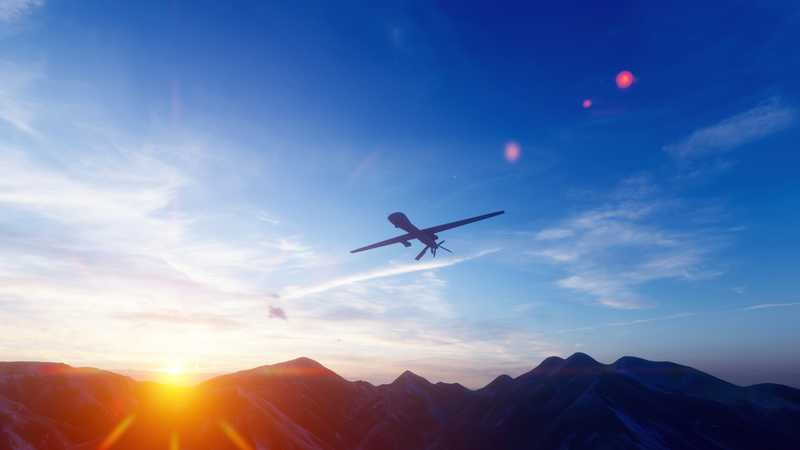
A military drone flies over a desert mountain plain at sunset.
A lack of Iranian-made kamikaze drones has been spotted in Ukraine since mid-February, the UK Defense Ministry assessed this week. Russian Forces have blown through the stockpile of precision-guided missiles and other munitions since the onset of the Ukraine invasion, making the possibility that its once fruitful arsenal of lethal drones may be suffering from a similar shortage.
The Defense Ministry’s report noted that Ukrainian Forces took out at least two dozen Iranian-designed Shahed-137 UAVs in the first half of February, indicating these killer drones remain a weapon of choice for Russian troops. While there may be a cessation in drone use currently, the Kremlin will likely secure a resupply of weapons from its authoritarian friends in Iran soon.
How Did Iranian-Made Drones Get to Russia?
Western intelligence and the Ukrainian government have confirmed the sale, delivery, training, and use of various Iranian-produced lethal drones by Russian Forces. Over the summer, the White House released footage depicting a Russian delegation visiting Iran’s primary drone airfield.
The satellite imagery clearly showcased a meeting between the delegation and its Iranian counterparts viewing Shahed-191 and Shahed-129 UAVs. Within a month, U.S. officials shared that Russian Forces began to undergo training to use these drones.
The introduction of these lethal weapons into the invasion has likely contributed to prolonging warfare. Although UAVs have dominated the skies over Ukraine since the onset of the conflict, the delivery of Iranian drones has single-handedly sustained Moscow’s dwindling aerial capabilities.
Why Kamikaze UAVs are so Powerful
Kamikaze drones, also known as suicide drones, are aerial weapons. Often referred to as “loitering munitions,” kamikaze drones are able to loiter in an area for some time and only attack once an enemy target is identified and located.
These drones are true assets in combat since they allow for quicker reaction times against hard-to-find targets that are often hidden from view. In addition to being small and easily launched, kamikaze drones are disposable weapons.
Unlike other sophisticated military drones that return to position once an attack is carried out, kamikaze drones are designed to self-destruct via detonation as it strikes a target.
An Assessment of Russia’s Go-To Suicide Drones
The Shahed family of lethal UAVs has provided Russia’s Air Force with the long-range strike capabilities it had been sorely missing. A prominently used variant of this drone family in Ukraine is the Shahed-136.
Referred to by Russian Forces as the Geranium-2, the drone is powered by a Chinese-made MD550 engine and has a range of a few thousand kilometers. Sporting explosives in a warhead on its nose, the Shahed-136 is a deadly addition to Moscow’s kamikaze drone arsenal.
Russia has used the Shahed-136 in frequent barrages targeting both military and civilian sites in Ukraine since the country acquired its first deliveries of Shahed-family drones in late summer.
Moscow has been largely directing its drones to attack Ukraine’s energy sector since the fall, hoping to force citizens and troops to go without warmth during the brutally cold winter months.
In December, Ukraine’s armed forces said it had been hit by at least 180 strikes over the span of a day, including by kamikaze UAVs. A U.S. Defense Intelligence Agency report released mid-February provided visual comparisons of Iranian drones and the UAVs used by Russia in Ukraine, confirming the frequency and ferocity of barrages carried out in recent months.
A cessation of Iranian-made UAV attacks may serve as a much-needed reprieve for Ukrainian forces. However, considering the strengthening relationship between the Kremlin and the Iranian regime, future shipments meant to replenish Moscow’s dwindling stock of kamikaze drones is likely imminent.
In fact, the Wall Street Journal recently reported that a joint Iranian-Russian drone factory could already be in the works.
- Iran’s Growing Missile Arsenal Is a Challenge for Israel - November 18, 2025
- IAI Is Hoping to Secure a Contract for the “Golden Dome” - November 3, 2025
- Trump dispatches B-1 bombers and other military assets to Venezuela - October 28, 2025
